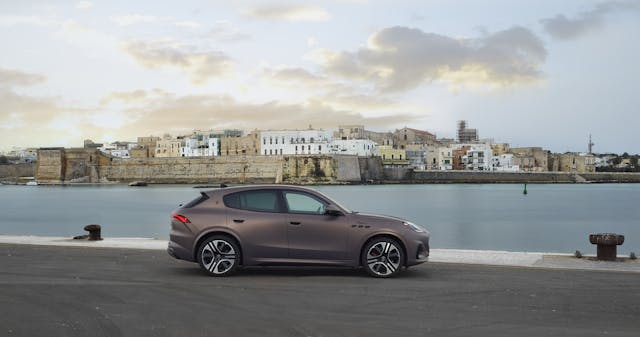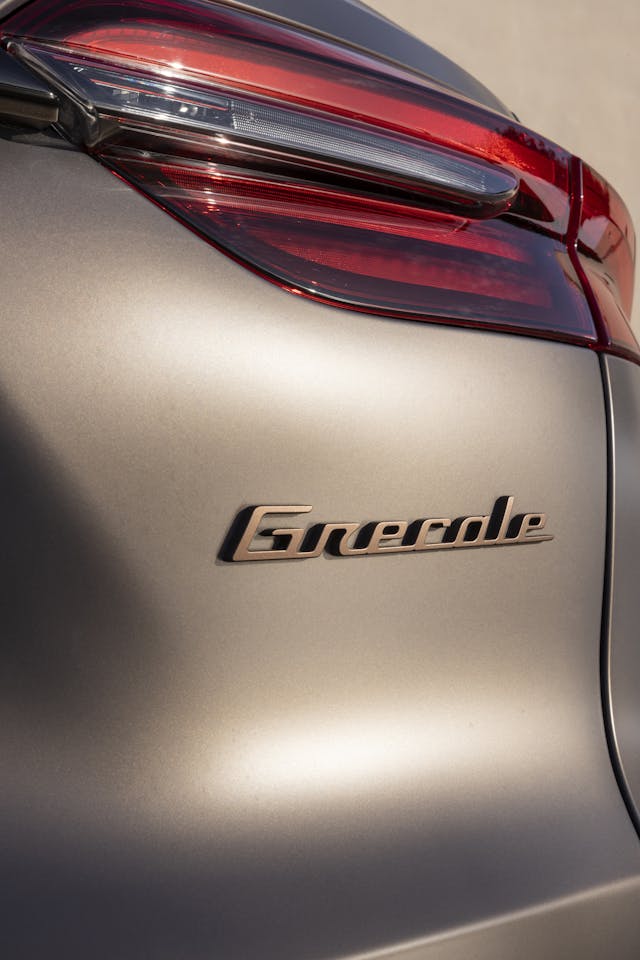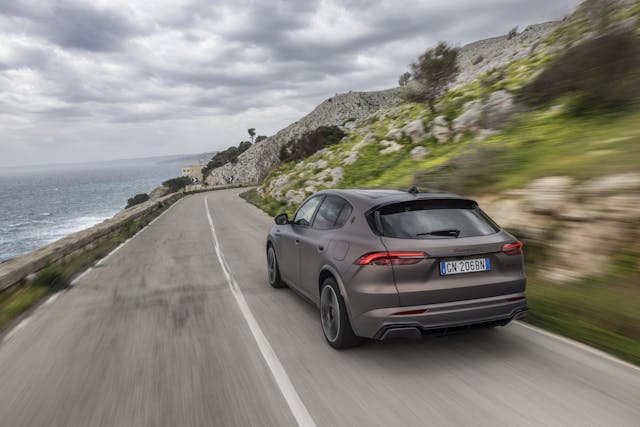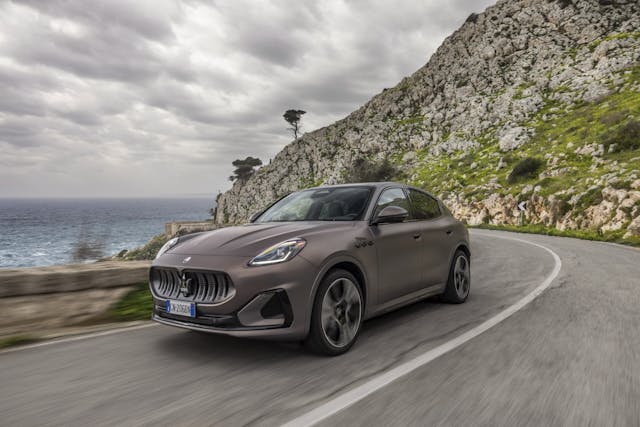2025 Maserati Grecale Folgore First Drive: Your Move, Macan EV
This year marks a turning point in the 110-year history of Maserati. Within the next 12 months or so, the Italian company’s entire range will be available with both combustion-engine and battery-electric power. The new lineup will be smaller—amid the demise of the Ghibli, Levante, and Quattroporte—and leading the way ahead is the Folgore (read: electric) variant of Maserati’s new Grecale SUV. The Grecale Folgore will be followed, in short succession, by electrified editions of the GranTurismo, GranCabrio, and MC20.
Folgore is Italian for lightning, making it the third EV named after Ben Franklin’s favorite phenomenon. (The Ford F-150 Lightning and the Chevy Bolt got there first, in English.) Maserati enters the electric SUV market in a unique niche. Until the arrival of the electric Porsche Macan, the Grecale Folgore will be the only high-performance, fully electric compact luxury SUV around.

Official pricing for the U.S. is not yet available, but we can expect something in the $115-$120K neighborhood, prior to accounting for the almost infinite custom “Fuoriserie” options. That means Maserati buyers will be paying a considerable premium over those shopping at BMW, Mercedes, or Audi. The larger Lotus Eletre, meanwhile, will start at roughly the same price.
This positioning will put the Folgore a smidge above pricing par with the 523-hp, Nettuno V-6-powered Grecale Trofeo, which starts a smidge under $110,000. With the EV version offering 560 horses, the two are close in performance despite the extra weight. Visually, they are almost identical aside from some subtle additions and deductions to distinguish electric from gas models.
Specs: 2025 Maserati Grecale Folgore
- Price: $115,000 (est.)
- Powertrain: 105-kWh battery, 2 x 280-hp permanent magnetic motors
- Output: 560 hp, 605 lb-ft
- Layout: Twin-motor, five-passenger, all-wheel-drive SUV
- Range: 311 miles (WLTP); EPA cycle TBD
- Competition: Porsche Macan EV
Sheet metal is unchanged compared with the gas model, but up front there is a new grille. Unlike many EVs, this one’s grille is still slatted, partly for cooling reasons but also for appearance; Maserati appears willing to sacrifice a few miles of range for a prettier face. Designers did consider aerodynamics, however, evidenced by a revised front spoiler, a completely flat underside, a specific rear diffuser, and trident-themed aero wheels that all contribute to the Grecale Folgore’s 0.305 Cd.
Maserati likes to say that the vehicle’s design theme stems from a central fuselage inspired by its Grand Prix racing cars of the 1950s. Does Alfa Romeo say the same about the Stelvio, I wonder? The two luxury compact crossovers are very closely related, sharing the same Giorgio platform, albeit stretched for Maserati.
That Giorgio platform, launched in 2015 for the Alfa Romeo Giulia sedan, is not a dedicated EV architecture. However, by adding totally new front and rear subframes to contain a pair of motors and a flat battery pack under the floor, Maserati has done a fine job of repackaging. (We’ll come back to the powertrain shortly.) The Folgore wears trident badging in copper as a nod to one of the metals most crucial to this electrification process.




Should you wish to double down on the reference, there’s a new brushed copper paint scheme called Rame, or if that’s not unusual enough, Maserati’s new Blue Graphite hue is textured in such a way to help emphasize the car’s curves. Touch it and you might be tempted to reach for a clay bar; it’s very different from a typical high-gloss polish.
There are more material innovations inside, with the seats a mix of leather and Econyl—a smooth and almost silky fabric made from recycled fishing nets and used by Gucci, Versace, and the like. Maserati’s version adds a laser to the manufacturing process to incorporate the pattern.
Copper reappears on the door caps and center console where it’s mixed with black in a weave-like plastic finish. The overall ambiance is indeed one of Italian luxury.

Maserati has maintained the same interior space as the combustion-powered Grecale, despite the packaging challenge of positioning batteries underneath the floor. It’s airy up front, and even those in the rear seats fare quite well as long as neither they nor the front passengers are too tall. With the front seats slid back, knee room does get a tad tight, but this is true of the Audi Q5 and Mercedes-Benz GLC as well. The car’s carrying capacity is a generous 19 cubic feet.
The driving position is almost infinitely adjustable, yet still a little taller than some may like—good for visibility but a loss for the car-driver connection. The main display is a sizable 12.3-inch unit and configured to host a range of drive-focused information that’s also complemented by a head-up display. In the center there’s an additional pair of touch screens (12.3 and 8.8 inches) joined together to resemble an open laptop. The bigger screen takes care of infotainment, navigation, and a multitude of safety settings, while the lower screen houses the HVAC controls. The whole setup works efficiently and with little lag, wirelessly links up with Apple CarPlay, Android Auto, and has clear graphics. Maserati’s classic dashboard clock is actually another digital display that works with voice control functions.
There are physical switches, but only to select Park, Drive and Reverse. Unfortunately, they’re a little lost against a piano-black background. If you find touchscreens to be fussy and distracting, this user-experience setup may well be a dealbreaker.
The premium audio system by Sonos Faber produces a clear sound and comes with 14 or 21 speakers with a 3D effect. Not available, however, is the wildly impressive Dolby Atmos surround sound we found bewitching in the Lotus Eletre.
Push the circular start button on the steering wheel and the speakers burst into life, delivering a gentle rumble to let you know the car is on. That sound, which is based around the frequencies of Maserati’s soon-dead V-8s, is always there, altering pitch in relation to road speed. The timbre changes depending on the driving mode and although you can’t switch it off, it’s easy enough to mentally tune it out—or drown it out with a shouty podcast or powerful track.
A second circular switch on the wheel dials up a choice of driving modes, adjusting the standard-issue air suspension and performance of the twin 205-kW motors. Go for MaxRange mode and, on Europe’s WLTP cycle, Maserati says you can drive 500km (311 miles) on a full charge. The Grecale Folgore aims to hit that target by reducing potential performance to 75 percent. You’ll want GT or Sport modes to experiece maximum attack and accelerate from 0-62 mph in 4.1 seconds or hit the top speed of 220 km/h (137 mph). An off-road setting raises the ride height for rougher stuff.

Maserati picked roads right on the southern tip of Puglia, Italy’s heel, to test the Grecale Folgore and, over 140-odd miles of highway and winding coast roads it acquitted itself extremely well.
There’s an ICE-like feel to the way it accelerates, not just because of that aural imitation of a V-8, but because, even in its most aggressive mode, the motors seem mapped to deliver progressive punch rather than the EV-typical brutal kick. Both axles always give an equal amount of oomph for optimum traction, and the whole setup feels sophisticated and mature. The same can be said of the ride and handling. Up front there are wishbones, while the rear has a multi-link arrangement. Air springs are standard and they adjust ride height to conditions and driver demands, turning in a fluid ride no matter the road surface. On the most curvaceous coast roads body control was excellent, as well.


The steering is sharp and direct, aiding confident turn-in. On the flip side, a strange inconsistency with the regenerative braking detracted from our experience. Pull the paddles behind the wheel to select between two levels of regeneration: a regular setting and one that allows additional coasting. The regen, which allows for one-pedal driving in the city, appears to be linked to how aggressively the accelerator has just been pressed rather than how it’s released. In practice we found it difficult to predict how much e-braking the system would provide, making it challenging to drive smoothly. The default mode, with both pedals used in conventional fashion, offered the best driving experience. Maserati’s engineers have said they’re taking another look at the calibration, so customer cars may be more consistent in quality across the modes.

Maserati says it wants to provide a seamless and luxurious EV ownership experience for Folgore buyers. To that end, every customer will be offered a wall box that can deliver up to 22 kW of charge, while a single card or app will give drivers access to a wide range of rapid chargers where the 105-kW battery pack can be juiced at up to 150 kW, meaning a 20-80 percent charge should take just 29 minutes and, when hooked up to a charger at the end of the day, the Folgore was able to reach the advertised rate.
What it couldn’t do, unsurprisingly, was meet the WLTP-rated range. 360 km (224 miles) was much more realistic based on my drive.
For a first venture into pure-electric power for a brand with such an illustrious past the Grecale Folgore bodes well. It’s quick, comfortable, and characterful, but I fear it may soon be outclassed in a head-to-head with the Macan. Until then, however, there’s a lot to recommend.
2025 Maserati Grecale Folgore
Highs: Sophisticated ride and handling, elegant styling and materials inside and out.
Lows: Expensive, inconsistent regenerative braking feel, range does not meet advertised rating.
Summary: The Maserati Grecale Folgore is currently in a class of one, but for how long?



Hmmmm…Let’s see….One Maserati dealer for every 11 Porsche dealers in the US…
and most of those Maser dealers are in the 4 Metro areas of the country (NY/NJ, Houston/Dallas, Chicago Metro, and LA/SF)
So, when the nice looking Maser breaks down/shuts off/stops, the warranty doesn’t matter.
You’re a jillion miles from quick help.
Get the free towing and the extended parts warranty.
Maserati has been to these shores 12 times in 60 years, and still has .0001% of buyers here in the US.
Maserati is not a volume brand. If a brand with many dealers and tons of units sold is the criteria, Toyota, Ford, and Chevrolet are the places to look. Where I live, the nearest Porsche dealer is no closer than the nearest Maserati dealer. If I lived in a different suburb, that might not be the case. Each buyer/owner needs to take into account dealer proximity (or lack thereof) when considering the ownership experience. But for many boutique brand owners, that’s not a primary consideration.
By the way, no one considers LA/SF to be one metro area. Residents of both would take offense to being lumped in with the other! 😆 But yes, Maserati dealers aren’t as plentiful. I found roughly twice as many Porsche dealers in a quick list/map search. It makes sense that with lower sales, there would be fewer dealers. But the top 50 metro areas are pretty well covered in the U.S. Even Idaho has a dealer. 🙂 And Minnesota, Alabama, Wisconsin, Indiana, Kentucky…you get the point. 😉
Can’t comment on Porsche as they have never really appealed to me. My son recently bought an Alfa from the Alfa/Maserati dealer in town. There are two, but the other is a lot further away. Anyways, he owned it for about 18 months and gave up because dealer and service support were terrible. Things broke in the first year and the dealer would say it was wear and tear, like when the steering wheel showed damage after such a short time. He is a Mercedes technician and said Merc would never treat their customers that way. HE sold the Alfa.
Try an expensive EV with a company with limited presence and a penchant for things breaking and expensive repairs. I realize Porsche is likely expensive also but at least it stands a better chance or going the distance than something from Stellantis. (Use only as directed.) I say get a Macan with a V6 while you still can.